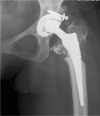Femoral shortening in total hip arthroplasty for high developmental dysplasia of the hip
- PMID: 20077043
- PMCID: PMC2881990
- DOI: 10.1007/s11999-009-1218-7
Femoral shortening in total hip arthroplasty for high developmental dysplasia of the hip
Abstract
Background: When reconstructing a hip with developmental dysplasia with a high dislocation, placing the acetabular component in the anatomic position can result in a prosthetic hip that is difficult to reduce. Subtrochanteric femoral osteotomy and shortening makes reduction easier but can be associated with complications (eg, limp, sciatic nerve injury, nonunion of the osteotomy) or compromise long-term stem survival.
Questions/purposes: We therefore evaluated (1) the short-term complication rate, (2) functional scores, and (3) survivorship of prostheses in patients with high developmental dysplasia of the hip reconstructed with femoral shortening.
Patients and methods: We prospectively followed 46 patients (65 hips) operated on from 1990 to 2000. There were 34 females and 12 males with a mean age of 48 years (range, 16-79 years). Before surgery, all patients had a positive Trendelenburg test. The minimum followup was 8 years (mean, 13 years; range, 8-18 years).
Results: One patient experienced recurrent dislocation and two peroneal nerve palsies, one of which partially recovered and one of which was permanent. In one patient, the stem subsided and after 8 months was replaced by a larger stem that stabilized. One patient had a nonunion but was functioning well and did not have additional surgery. At followup, 12 of the 65 hips (18%) had a positive Trendelenburg test. The mean muscle strength of the abductors was 4 (range, 3-5). The mean Harris hip score was 87 (range, 59-100) and the mean visual analog scale pain score 81 (range, 35-100). At followup, all stems were well fixed with no obvious signs of radiographic loosening. Ten cups were revised because of aseptic loosening.
Conclusions: Our data suggest femoral osteotomy and shortening at the subtrochanteric level predictably allows a stable reduction in patients with high developmental dysplasia of the hip and does not lead to any reduction in long-term survival.
Level of evidence: Level II, prognostic study. See Guidelines for Authors for a complete description of levels of evidence.
Figures



Similar articles
-
Subtrochanteric Shortening Osteotomy Provides Superior Function to Trochanter Slide Osteotomy in THA for Patients With Unilateral Crowe Type IV Dysplasia at a Minimum of 3 Years.Clin Orthop Relat Res. 2024 Jun 1;482(6):1038-1047. doi: 10.1097/CORR.0000000000002900. Epub 2023 Oct 27. Clin Orthop Relat Res. 2024. PMID: 37889537 Free PMC article.
-
Total hip arthroplasty with shortening subtrochanteric osteotomy in Crowe type-IV developmental dysplasia: surgical technique.J Bone Joint Surg Am. 2010 Sep;92 Suppl 1 Pt 2:176-87. doi: 10.2106/JBJS.J.00061. J Bone Joint Surg Am. 2010. PMID: 20844173
-
[COMPARISON OF CEMENTLESS TOTAL HIP ARTHROPLASTY BETWEEN WITH AND WITHOUT SUBTROCHANTERIC FEMORAL SHORTENING OSTEOTOMY IN Crowe TYPE IV DEVELOPMENTAL DYSPLASIA OF HIP].Zhongguo Xiu Fu Chong Jian Wai Ke Za Zhi. 2015 Feb;29(2):154-9. Zhongguo Xiu Fu Chong Jian Wai Ke Za Zhi. 2015. PMID: 26455140 Chinese.
-
One-third of Hips After Periacetabular Osteotomy Survive 30 Years With Good Clinical Results, No Progression of Arthritis, or Conversion to THA.Clin Orthop Relat Res. 2017 Apr;475(4):1154-1168. doi: 10.1007/s11999-016-5169-5. Clin Orthop Relat Res. 2017. PMID: 27905061 Free PMC article.
-
Total hip replacement fifteen years after pelvic support osteotomy (PSO): a case report and review of the literature.Musculoskelet Surg. 2012 Aug;96(2):141-7. doi: 10.1007/s12306-011-0178-8. Epub 2012 Jan 12. Musculoskelet Surg. 2012. PMID: 22237840 Review.
Cited by
-
Changes of gluteus medius muscle in the adult patients with unilateral developmental dysplasia of the hip.BMC Musculoskelet Disord. 2012 Jun 15;13:101. doi: 10.1186/1471-2474-13-101. BMC Musculoskelet Disord. 2012. PMID: 22703548 Free PMC article.
-
[Total hip arthroplasty with Wagner Cone stem and subtrochanteric shortening osteotomy in treatment of Crowe Ⅳ developmental dysplasia of hip in adults].Zhongguo Xiu Fu Chong Jian Wai Ke Za Zhi. 2019 Aug 15;33(8):929-934. doi: 10.7507/1002-1892.201810062. Zhongguo Xiu Fu Chong Jian Wai Ke Za Zhi. 2019. PMID: 31407548 Free PMC article. Chinese.
-
Mid-term results of total hip arthroplasty with modified trochanteric osteotomy in Crowe type IV developmental dysplasia of the hip.BMC Surg. 2021 Jan 6;21(1):9. doi: 10.1186/s12893-020-01002-4. BMC Surg. 2021. PMID: 33407340 Free PMC article.
-
[Total hip replacement in developmental dysplasia: anatomical features and technical pitfalls].Orthopade. 2011 Jun;40(6):543-53. doi: 10.1007/s00132-011-1754-1. Orthopade. 2011. PMID: 21562860 German.
-
Total hip arthroplasty (S-ROM stem) and subtrochanteric osteotomy for Crowe type IV developmental dysplasia of the hip.Indian J Orthop. 2016 Mar-Apr;50(2):195-200. doi: 10.4103/0019-5413.177575. Indian J Orthop. 2016. PMID: 27053810 Free PMC article.
References
-
- Argenson JN, Flecher X, Parratte S, Aubaniac JM. Anatomy of the dysplastic hip and consequences for total hip arthroplasty. Clin Orthop Relat Res. 2007;465:40–45. - PubMed
-
- Callaghan JJ, Forest EE, Sporer SM, Goetz DD, Johnston RC. Total hip arthroplasty in the young adult. Clin Orthop Relat Res. 1997;344:257–262. - PubMed
-
- DeLee JG, Charnley J. Radiological demarcation of cemented sockets in total hip replacement. Clin Orthop Relat Res. 1976;121:20–32. - PubMed
MeSH terms
LinkOut - more resources
Full Text Sources
Medical
Research Materials

